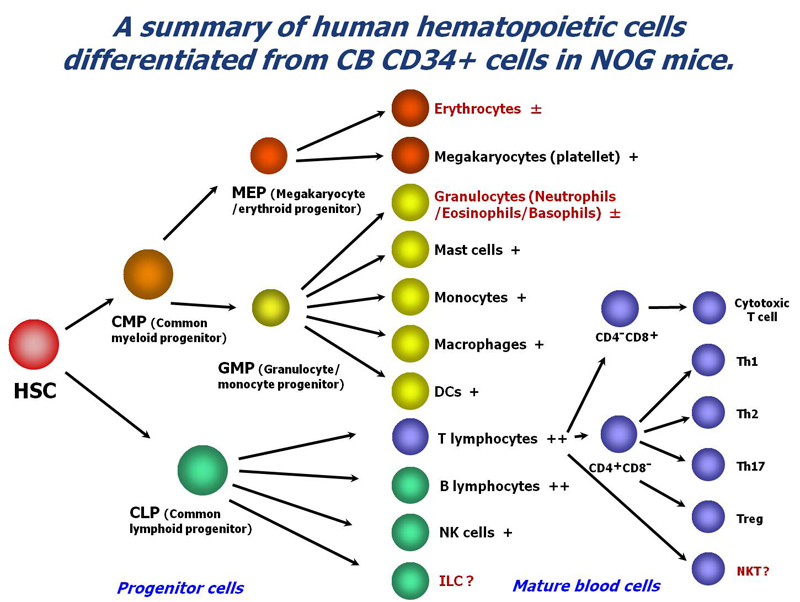Immunology Laboratory
Immunology laboratory has succeeded in the development of the NOD-scid IL-2Rgnull (NOG) mouse,
an immunodeficient mouse with excellent engraftment potential of heterologous cells and tissues including humans’,
and is creating "humanized mice" with human blood and immune systems using this mouse.
Currently, based on the NOG mice, "next generation NOG mice",
which are genetically modified by introduction of various human genes or mouse gene deficiencies, have been developed.
We are attempting to ① identify essential molecules to reconstruct functional human blood and immune systems,
and ②further improve the efficiency of engraftment of both normal and pathological human tissues through elucidating
the molecular mechanisms by which the mouse immune system recognizes exogenous substances.
In addition, we are developing experimental systems in which immune reactions to xenogeneic human tumors become possible using humanized mice.
Through the development of these mice, we aim to support more efficient new drug development.
※References
-
Development of a novel humanized mouse model for improved evaluation of in vivo anti-cancer effects of anti-PD-1 antibody
Katano I, Hanazawa A, Otsuka I, Yamaguchi T, Mochizuki M, Kawai K, Ito R, Goto M, Kagawa T, Takahashi T.
Sci Rep. 2021 Oct 26;11(1):21087.
-
Improved Detection of in vivo Human NK Cell-Mediated Antibody-Dependent Cellular Cytotoxicity Using a Novel NOG-FcγR-Deficient Human IL-15 Transgenic Mouse.
Katano I, Ito R, Kawai K, Takahashi T.
Front Immunol. 2020 Oct 7;11:532684.
-
Human Interleukin-34 facilitates microglia-like cell differentiation and persistent HIV-1 infection in humanized mice.
Mathews S, Branch Woods A, Katano I, Makarov E, Thomas MB, Gendelman HE, Poluektova LY, Ito M, Gorantla S.
Mol Neurodegener. 2019 Mar 5;14(1):12.
-
Generation of Human Immunosuppressive Myeloid Cell Populations in Human Interleukin-6 Transgenic NOG Mice.
Hanazawa A, Ito R, Katano I, Kawai K, Goto M, Suemizu H, Kawakami Y, Ito M, Takahashi T.
Front Immunol. 2018 Feb 2;9:152.
-
Enhanced Antibody Responses in a Novel NOG Transgenic Mouse with Restored Lymph Node Organogenesis.
Takahashi T, Katano I, Ito R, Goto M, Abe H, Mizuno S, Kawai K, Sugiyama F, Ito M.
Front Immunol. 2018 Jan 17;8:2017.
-
Long-term maintenance of peripheral blood derived human NK cells in a novel human IL-15- transgenic NOG mouse.
Katano I, Nishime C, Ito R, Kamisako T, Mizusawa T, Ka Y, Ogura T, Suemizu H, Kawakami Y, Ito M, Takahashi T.
Sci Rep. 2017 Dec 8;7(1):17230.
-
Antitumor Effect of Programmed Death-1 (PD-1) Blockade in Humanized the NOG-MHC Double Knockout Mouse.
Ashizawa T, Iizuka A, Nonomura C, Kondou R, Maeda C, Miyata H, Sugino T, Mitsuya K, Hayashi N, Nakasu Y, Maruyama K, Yamaguchi K, Katano I, Ito M, Akiyama Y.
Clin Cancer Res. 2017 Jan 1;23(1):149-158.
-
Predominant development of mature and functional human NK cells in a novel human IL-2-producing transgenic NOG mouse.
Katano I, Takahashi T, Ito R, Kamisako T, Mizusawa T, Ka Y, Ogura T, Suemizu H, Kawakami Y, Ito M.
J Immunol. 2015 Apr 1;194(7):3513-25.
-
Visualization of the human CD4⁺ T-cell response in humanized HLA-DR4-expressing NOD/Shi-scid/γc(null) (NOG) mice by retrogenic expression of the human TCR gene.
Takahashi T, Katano I, Ito R, Ito M.
Biochem Biophys Res Commun. 2015 Jan 2;456(1):219-24.
-
NOD-Rag2null IL-2Rγnull mice: an alternative to NOG mice for generation of humanized mice.
Katano I, Ito R, Kamisako T, Eto T, Ogura T, Kawai K, Suemizu H, Takahashi T, Kawakami Y, Ito M.
Exp Anim. 2014;63(3):321-30.

